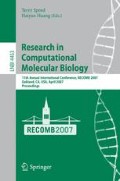Abstract
With the increasing availability of experimental data on gene-gene and protein-protein interactions, modeling of gene regulatory networks has gained a special attention lately. To have a better understanding of these networks it is necessary to capture their dynamical properties, by computing its steady states. Various methods have been proposed to compute steady states but almost all of them suffer from the state space explosion problem with the increasing size of the networks. Hence it becomes difficult to model even moderate sized networks using these techniques. In this paper, we present a new representation of gene regulatory networks, which facilitates the steady state computation of networks as large as 1200 nodes and 5000 edges. We benchmarked and validated our algorithm on the T helper model from [8] and performed in silico knock out experiments: showing both a reduction in computation time and correct steady state identification.
Access this chapter
Tax calculation will be finalised at checkout
Purchases are for personal use only
Preview
Unable to display preview. Download preview PDF.
References
Bryant, R.E.: Graph-Based Algorithms for Boolean Function Manipulation. IEEE Trans. on Computers 35, 677–691 (1986)
Burch, J.R., Clarke, E.M., Long, D.E., MacMillan, K.L., Dill, D.L.: Symbolic Model Checking for Sequential Circuit Verification. IEEE Trans. on Computer-Aided Design of Integrated Circuits and Systems 13, 401–424 (1994)
Touati, H.J, Savoj, H., Lin, B., Brayton, R.K., Sangiovanni-Vincentelli, A.: Implicit state enumeration of finite-state machines using BDDs. In: Proc. of ICCAD (1990)
Agnello, D., Lankford, C.S.R., Bream, J., Morinobu, A., Gadina, M., OShea, J., Frucht, D.M.: Cytokines and transcription factors that regulate T helper cell differentiation: new players and new insights. J. Clin. Immun. 23, 147–162 (2003)
Bergmann, C., van Hemmen, J.L.: Th1 or Th2: how an appropriate T helper response can be made. Bull. Math. Bio. 63, 405–430 (2001)
Krueger, G.R., Marshall, G.R., Junker, U., Schroeder, H., Buja, L.M., Wang, G.: Growth factors, cytokines, chemokines and neuropeptides in the modeling of T-cells. In Vivo 16, 365–586 (2002)
Mendoza, L.: A network model for the control of the differentiation process in Th cells. BioSystems 84, 101–114 (2006)
Mendoza, L., Xenarios, I.: A method for the generation of standardized qualitative dynamical systems of regulatory networks. Theoretical Biology and Medical Modelling 3 (2006)
Mendoza, L., Thieffry, D., Alvarez-Buylla, E.R.: Genetic control of flower morphogenesis in Arabidopsis thaliana: a logical analysis. BioInfo. 15, 593–606 (1999)
Murphy, K.M., Reiner, S.L.: The lineage decisions on helper T cells. Nat. Rev. Immun. 2, 933–944 (2002)
Szabo, S.J., Sullivan, B.M., Peng, S.L., Glimcher, L.H.: Molecular mechanisms regulating Th1 immune responses. Ann. Rev. Immun. 21, 713–758 (2003)
Thieffry, D., Sánchez, L.: Alternative epigenetic states understood in terms of specific regulatory structures. Ann. N.Y. Acad. Sci. 981, 135–153 (2002)
Sánchez, L., Thieffry, D.: Segmenting the fly embryo: a logical analysis of the pair-rule cross-regulatory module. Jour. Theo. Bio. 224, 517–537 (2003)
Thomas, R.: Regulatory networks seen as asynchronous automata: a logical description. Jour. Theo. Bio. 153, 1–23 (1991)
Thomas, R., Thieffry, D., Kaufman, M.: Dynamical behaviour of biological regulatory networks-I. Biological role of feedback loops and practical use of the concept of the loop-characteristic state. Bull. Math. Biology 57, 247–276 (1995)
Weisbuch, G., DeBoer, R.J., Perelson, A.S.: Localized memories in idiotypic networks. Jour. Theo. Bio. 146, 483–499 (1990)
Yates, A., Bergmann, C., van Hemmen, J.L., Stark, J., Callard, R.: Cytokine-modulated regulation of helper T cell populations. Jour. Theo. Bio. 206, 539–560 (2000)
Xie, A., Beerel, P.A.: Efficient State Classification of Finite State Markov Chains. In: Proc. of DAC (1998)
Hachtel, G., Macii, E., Pardo, A., Somenzi, F.: Markovian analysis of large finite state machines. IEEE Trans. on CAD 15, 1479–1493 (1996)
Somenzi, F.: CUDD: CU Decision Diagram Package Release 2.4.1. University of Colorado at Boulder (2005)
Brayton, R.K., Sangiovanni-Vincentelli, A.L., McMullen, C.T., Hachtel, G.D.: Logic Minimization Algorithms for VLSI Synthesis. Kluwer Academic Publishers, Dordrecht (1984)
DeMicheli, G.: Synthesis and Optimization of Digital Circuits. McGraw-Hill Higher Education, New York (1994)
Burch, J.R., Clarke, E.M., MacMillan, K.L., Dill, D.L., Hwang, L.H.: Symbolic Model Checking: 1020 States and Beyond. In: Proc. of the IEEE Symp. on Logic in Computer Science, IEEE Computer Society Press, Los Alamitos (1990)
Alur, R., Henzinger, T.A., Mang, F.Y.C., Qadeer, S., Rajamani, S.K., Tasiran, S.: MOCHA: Modularity in Model Checking. In: CAV (1998)
Diehl, S., Anguita, J., Hoffmeyer, A., Zapton, T., Ihle, J.N., Fikrig, E., Rincón, M.: Inhibition of Th1 differentiation by IL-6 is mediated by SOCS1. Immunity 13, 805–815 (2000)
Tang, H., Sharp, G.C., Peterson, K.P., Braley-Mullen, H.: IFN-g-deficient mice develop severe granulomatous experimental autoimmune thyroiditis with eosinophil infiltration in thyroids. Jour. Immun. 160, 5105–5112 (1998)
Bernot, G., Comet, J.P., Richard, A., Guespin, J.: Application of formal methods to biological regulatory networks: extending Thomas’ asynchronous logical approach with temporal logic. Jour. Theo. Bio. 229, 339–347 (2004)
Devloo, V., Hansen, P., Labb, M.: Identification Of All Steady States In Large Biological Systems By Logical Analysis. Bull. Math. Bio. 65, 1025–1051 (2003)
Chabrier, N., Fages, F., Soliman, S.: BIOCHAM. In: Proc. of CMSB (May 2004)
Author information
Authors and Affiliations
Editor information
Rights and permissions
Copyright information
© 2007 Springer Berlin Heidelberg
About this paper
Cite this paper
Garg, A., Xenarios, I., Mendoza, L., DeMicheli, G. (2007). An Efficient Method for Dynamic Analysis of Gene Regulatory Networks and in silico Gene Perturbation Experiments. In: Speed, T., Huang, H. (eds) Research in Computational Molecular Biology. RECOMB 2007. Lecture Notes in Computer Science(), vol 4453. Springer, Berlin, Heidelberg. https://doi.org/10.1007/978-3-540-71681-5_5
Download citation
DOI: https://doi.org/10.1007/978-3-540-71681-5_5
Publisher Name: Springer, Berlin, Heidelberg
Print ISBN: 978-3-540-71680-8
Online ISBN: 978-3-540-71681-5
eBook Packages: Computer ScienceComputer Science (R0)

